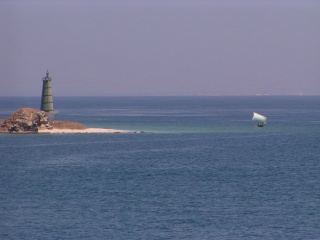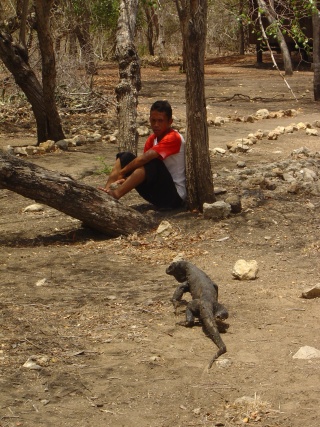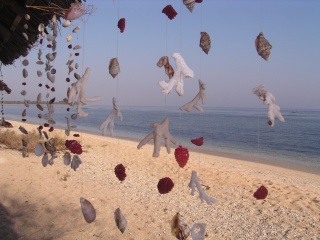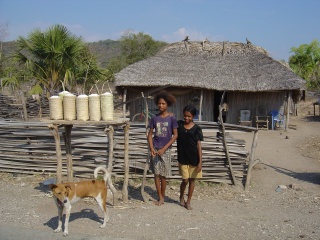Indonesia (Nusa Tengara) and Timor Leste
After our luxurious break in Bali we reluctantly packed the bike again and left for the island of Lombok in search of more adventure.

Click here to see Lisa and friend
The four hour ferry crossing became a seven hour one as, when the boat arrived in Lomboks little port there were still two ferries unloading. Our boat waited in the bay for three hours while all the trucks on board revved their engines and honked their horns, ready to go, even though the boat wasnt docked.
By this time it was dark but we decided to risk riding for half an hour up to the town of Senggigi. Not a good idea on roads we didnt know but luckily and surprisingly they were in excellent condition and we didnt have much more than goats running into our path in the moonless night. We found a good cheap guesthouse and the owner cooked us a big snapper with rice and salad for dinner.
The next morning we headed up to the north of the island, passing some incredibly beautiful beaches on the way. We arrived at the small town of Bangsal where little boats wait to take people out to the Gili islands, only 30 minutes away. Our guidebook describes this town as the armpit of Indonesia as the locals hassle, lie and try to cheat tourists out of money while their children beg and try to pickpocket them. Rich felt little hands touching his while he stood there with his hands firmly in his pockets. We spent an age trying to get a good price for a boat and were relieved to finally depart.
The three tiny islands forming the Gilis are beautiful, specks of white sand floating in the clear turquoise waters. We spent two nights on Gili Meno, eating fresh fish and snorkeling with huge turtles. It takes an hour, at a very relaxed pace to walk around the island, there are no vehicles as there is only a narrow sand road ringing the island on which little ponies pull carts, people and their luggage. The island is dry and water has to be shipped in from Lombok so we purchased 30 litre buckets of it to shower with after our swimming. Theres boats running daily to the mainland but the supplies are basic and there were few tourists so we really felt like wed got away from it all and were relaxing. Again. We seem to be getting good at it.
Continuing our ride around the north of Lombok we stopped for a night at a quiet guesthouse right at the foot of Mt Rinjani, watching the volcanic landscape change colour, first in the sunset and then with the next mornings sunrise. Weve overheard lots of tourists saying the two day, one night climb up this volcano was the best thing they did in Indonesia as it has a beautiful turquoise lake and hot pools inside the crater. Alas, no time for us to engage in such strenuous activities, the clock is ticking on our visa and we need to head east again.

click here to see Gunung Rinjani sunrise
Morning time we wound down out of the hills to the port for the 90 minute crossing to the island of Sumbawa. We were surprised to find Sumbawa has a far more arid landscape than Lombok, its hotter and drier and the communities seem poorer. Theres a lot of salt farming and the brown landscape is dotted with big mounds of the coarse grains.
Most tourists transit Sumbawa on a grueling overnight minibus, getting to see almost nothing of the hilly island, its coastline of shallow water, mangroves, fish farms and fishing villages. The Lonely Planet is short on sites for the tourist but we did take a bumpy little road down to Lakey Beach at Huu on the south coast. We found 30 or so surfers enjoying the reef break here and we stayed a couple of nights relaxing on the white sand beach, eating huge fish and sleeping in each morning.

click here to see what 6 people ate for lunch and dinner
Some Aussies lent us their snorkeling gear saying it was the best snorkeling theyd ever done but also offered us their spear guns as there are lots of big sharks and theyd had to give one a little jab when it came too close. We got in the water and swam around a bit but wimped out going outside the reef as wed timed our swim for dusk, feeding time just a little too late to make us feel easy about it.
We had a very hot days ride to the basic little town of Sape on the east coast, where the ferry leaves for the island of Flores. Tiny horses decorated with bright coloured pom poms and tassles pull little carts laden high with people and produce to and from the wharf.
Ferries plying the waters between the various Indonesian islands change schedule frequently and its difficult to get any accurate information on sailing times without actually being there. The departure time wed expected had changed and we had to wait a whole 24 hours here in a hot guesthouse across from the briny seashore. In the evening we wandered amongst the colourful wooden houses set on stilts on the muddy mangroved shoreline. The locals came out on their verandahs to look at us looking at them and babies were produced for us to photograph. We became pied pipers with giggling village children following us as we wandered and watched local workmen craft big wooden boats set on the mud next to their homes.

click here to see Lisa and friends
Finally we were on our way to Flores. The 4pm crossing left at 7pm as overloaded trucks attempted to roll on to the ferry, found they were too high and had to be unloaded. By then the boat was filling up with chickens, goats, sacks of vegetables and human livestock. By the time we left I was ready to be there, having sat in an open sided but hot floating metal container with no breeze for 3 hours. By 10ish most people had stopped smoking and the TV was turned down so we each stretched out along a set of 5 moulded and very hard fiberglass seats to try to sleep. Ive seen so many people sleeping on these before that I thought they couldnt be that bad, but they are and by the time the boat arrived at 3am we were bruised, sore, sleepy and a little grumpy. We woke 2 guesthouse owners to hear they were full for the night then rode up to find a room at a lovely guesthouse on the hill with incredible views overlooking Labuanbajos quiet bay.
From Labuanbajo we hired a little boat to take us out to stay overnight on the island of Rinca which, like its neighbour Komodo, is the home of dragons. Our captain was a real old salt who knew the swirling seas of Komodo National Park well and Rich and I were thrilled to be on the still water. We watched dolphins jumping as we sipped weak tea and took photos of each other and all the little picture postcard islands we passed.
I was rather nervous of being around the Komodo dragons having seen how ferocious they are from television documentaries. They are giant monitor lizards that seem sedentary but can run at 18 km/hour, they have huge, strong bodies and rise up onto their hind legs to fight.
Pulling into a little bay we could see huge and magnificent mangroves and little monkeys playing on the muddy shore and looking down in the clear water we saw tiny coloured fish playing with the anchor moorings and jetty pilings. My peace was disturbed when someone announced there was a dragon at the end of the jetty which we virtually had to walk over to get to the park camp. Fortunately it appeared to be sleeping but I was pretty nervous on the five minute walk with our captain across the dry salty land. We were amused to read a sign telling us any visitors holding a National Park entry ticket were insured under some obscure local life insurance policy not dreadfully reassuring for the already nervous.

click here to see confidence inspiring sign
Dragons surrounded the camp, sleeping under buildings and trees. We paid our Park entry fees then were shown our room, led by a ranger carrying a long stick, forked at one end which you are supposed to use to pin over the neck of any attacking dragon. They are so fast and so strong I doubted my ability to be able to defend myself but soon adopted the stick carrying approach for my own peace of mind. We sat talking to some student rangers then were alerted to some disturbance over by the toilet block, running and yelling. We raced over to see that a deer, which had come in to have a drink in the pool of water next to the toilet block, had been caught in the teeth of a dragon. These teeth are rather tiny but razor sharp and they clamp their victims in their strong jaws. There is no antidote for 3 of the bacteria living in their saliva so prey which get away from an attack with only a small wound will usually die anyway.

click here for another gory image
This deer wasnt going to get away though. Its leg was firmly clamped in the dragons jaws and 3 others were circling within minutes there were about 15 dragons around. The deer was pulled to its knees, then as dragons climbed all over it, it fell to its side, being devoured. It wasnt until its warm, pumping heart was ripped out of its body that we saw life fade from its eyes.
The rangers here are surprisingly unconcerned around the dragons, even walking within a couple of meters of them but after seeing this feast we continued to be wary. We made sure we drank less than usual in the afternoon so we didnt have to get up in the night and kept our room door closed as they can climb stairs. Rangers find them in the kitchen, toilet and offices if doors are left open.

click here to see what lurks in the toilet
Aside from the dragons, lots of people come to Komodo National Park for its fantastic diving. We dont dive but love snorkeling so on our way back to Labuanbajo, we stopped at a tiny, deserted island and spent a couple of hours going wow at the amazing coloured coral, fish and strange sea creatures. This is the best snorkeling weve ever done and we got out of the water completely buzzing from the experience.
We rode east into the centre of Flores, over windy roads with cicadas screaming from lush jungle, past green rice paddies, banana plantations, coffee plants blooming with tiny sweet white flowers, coconut palms, cloves, corn, mango, avocado and tamarind but also down through some dry rain deprived valleys. Everywhere the universal smile and wave kept us going through the long hot days.

click here to see Ikat vendors
We visited several traditional villages; where people retain strong animist beliefs and worship totems to their ancestors. We passed many volcanoes standing magnificent against the blue sky. Our search for pump petrol and internet cafes grows increasingly desperate the further from Bali we go but we settle for fillups from 1litre plastic bottles sold from shop fronts and hideously slow and expensive connections found, if we are lucky one or two per island.
We arrive late in the evening at Moni, the village set at the base of Mt Kelimutu. The pick of the accommodation is gone so we get the cheapest rooms in town, like a homestay which doubles as an old folks home and a knocking shop rolled into one. Despite the thin walls we manage to wake at 5am with our alarm in order to get up and see the sunrise over Mt Kelimutu. We look out the window and seeing that its still pitch black and that its only a 13km ride up the hill, we decide we can have a 15 minute sleep in. Of course by the time we get half way up the very windy hill with its very bad roads the sun is on its way up and the clouds are turning a beautiful pink and orange hue. By the time we park the bike and walk the last 100m up to the crater rim the bright sun is glaring back at us and as with Mt Bromo we are just 15 minutes too late which is a silly move if youve made the effort to get up and see a sunrise. Mt Kelimutu has 3 lakes set down within its crater, one a bright turquoise, another coffee coloured and a third a deep reddish black. We waited for the sun to show off the colour of the lakes before descending past vendors selling the local ikat weaving and farmers in the rice fields.

click here to see Ikat at Kelimutu
Continuing east, we spent a couple of nights relaxing, being the only guests at the very simple Sunset Cottages at a lovely beach just short of the eastern end of Flores. We were their first guests for three weeks as a nearby volcano had been erupting, covering the beach in ash and keeping tourists well away.
We rode on to catch our ferry to Timor and after fighting hoards of queue jumpers we managed to buy a ticket and get on the boat. We were apparently late on despite arriving 2 hours before departure and the entire vehicle level of the boat was already full. We battled to get baskets of bananas and chickens and old women lying on woven mats to move so that we could tie the bike down.

click here to see vehicle deck
This, our last Indonesian boat crossing was definitely our worst leave at 2pm and arrive the next morning at 6am. We managed to get two seats near the front next to the television set, a very big speaker and a group of nuns at least they wouldnt be blowing cigarette smoke at us all the way. When the ticket inspector came to check our tickets we enquired about upgrading. He suggested we go upstairs to the crew deck for the trip so we took up his offer and got to spend it on the open air deck alone. The moon was full and there was a cool breeze so we had a peaceful time and managed to lie down and get some sleep.
Wed planned to spend a few days exploring Timor but there are few tourist attractions and food and accommodation is generally more expensive for poorer quality than the rest of Indonesia. Weve seen some interesting Timorese crafts in Bali and other places - weaving, wooden carving and statues but as there is so little tourism in Timor its really difficult to find shops to view this.
We did pass some interesting houses, beehive shaped and made from straw with doors no more than a meter high. Apparently the government has deemed these unfit for living in and has built newer concrete homes for the residents but they claim the new houses are too big and cold so continue to use their traditional homes.

click here to see more Ikat vendors
Our last night in Indonesia was spent at the border town of Atambua, which has had a rather violent past. Many of the militias that wreaked havoc on Timor Leste (East Timor) crossed the border when the UN arrived and were encamped around Atambua. There is still a very sizable military presence in town and we were apprehensive about the reception we would receive. This was soon dispelled as we found everything very calm and people friendly although there is definitely no love lost with their neighbour Timor Leste.
We want to go to Australia but there is no shipping from this far east in Indonesia, it could have only been done from Java or Bali which we left behind weeks ago. Our only option is to go to Timor Leste and send the bike on Perkins twice weekly container ship from Dili to Darwin. Crossing to Timor Leste involved tighter security than wed been used to for a while with lots of police and UN guards monitoring the border.
We entered Timor Leste and followed the road north along the coast to the capital, Dili through some desolate villages where subsistence salt farmers evaporate water to leave salt by lighting fires with wood cut from trees they dont own.
Like so many places in the world, there is a big deforestation problem here and the dry sandy soil washes away in the wet season. Indonesians had warned us how bad the Timor Leste roads were but they were no different from those in their country. We were overtaken by lots of big 4WDs racing back to the capital all with UN or other aid agency emblems emblazoned across their sides. Timor Leste has never had much of a tourist infrastructure and we passed some really beautiful beaches that we would have loved to spend some time at, had there been accommodation for us.
Instead we made for Dili, where the UN and the US dollar have ensured prices have soared well above what the locals can afford and was even expensive on our budget. The boom industry for the locals has been providing accommodation for the aid workers and prices are steep, starting at around US$40 for a small room converted from an old shipping container. There is one $5/night guesthouse which is always full but we headed for a family home which rents rooms to people and operates on a word of mouth basis. Despite the daily power cuts it was a quiet haven where we could cook, organise our shipping and clean the bike. Dili is a small, flat, dry town and every street has at least one, but usually many devastated buildings. The violence in 1999 that left the country totally paralysed has left a longer legacy in these concrete skeletons many with weeds growing out through their bare windows. They will eventually be destroyed or like others, renovated for aid offices but in the meantime they sit empty and quiet, a reminder of the recent troubled past.
On the Friday we made arrangements with Perkins agents to send the bike on the Tuesday crossing to Darwin. That left us the weekend to clean it sufficiently to comply with Australias strict quarantine regulations no dirt, no bugs and no seeds to enter the country. Our friends had spent a week cleaning their bikes so we didnt have a lot of time. I started by washing our backpacks that were minging with road grease and dirt, our boots, our wet weather gear, the bike rags, the tools, the bungies and webbing tie downs. Everything was dirty and greasy and it all had to be cleaned. Meanwhile Rich had come down with a fever and was making slow progress on the bike. By the end of Saturday hed slowed to a standstill with aching muscles and nausea. We suspected malaria so visited a doctor but the blood tests came back negative, thank goodness. By Monday night wed visited 2 car wash yards giving the bike a power clean each time and finally it had to go, clean enough or not. Rich rode it into a container, strapped it down, paid our money and we left, hoping it would be sent the next day.

click here to see Timor Leste parliment
Meanwhile we had applied for Indonesian visas again as Air North have a monopoly on flights to Darwin and unsurprisingly they arent cheap. Merpati fly from Kupang in West Timor for US$100 cheaper per ticket. So we got our visas and braved a long minibus ride back through the countryside wed just covered. It took 12 hours and fortunately the minibus was comfortable and airconditioned and Rich finally got to look around and see the scenery properly. We spent a couple of nights in Kupang eating seafood again before hopping on a little 30 seater plane for the hour and a half crossing to Australia.
After many miles and many adventures we have finally completed our crossing of Asia. Only one more country to cross before we finally reach New Zealand and the end of our journey.












